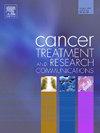不可切除的III期非小细胞肺癌放化疗后Durvalumab巩固:来自澳大利亚PACIFIC-R亚群的真实世界经验
IF 2.4
Q3 Medicine
引用次数: 0
摘要
多中心PACIFIC-R研究(NCT03798535)的澳大利亚亚组在放化疗后无进展的不可切除III期非小细胞肺癌患者中发现,中位无进展生存期为22.4个月(95%置信区间,17.5至30.8),证实了在现实环境中,durvalumab在放化疗后巩固的临床益处。3期PACIFIC试验将化疗后(CRT) durvalumab巩固作为不可切除的III期非小细胞肺癌(NSCLC)患者的标准治疗。我们报告了多中心PACIFIC-R研究(NCT03798535)澳大利亚亚组的结果,该研究评估了durvalumab在现实环境中的有效性。患者和方法纳入了2017年9月至2019年12月期间通过早期准入计划(EAP)接受至少1剂量durvalumab (10mg /kg静脉注射,每2周)的不可切除III期NSCLC患者,CRT后无进展。主要终点、无进展生存期(PFS)和总生存期(OS)采用Kaplan-Meier法分析。结果:截至2022年2月7日,纳入165例患者(中位年龄67.0岁),中位随访时间为34.7个月。大多数患者在durvalumab起始治疗前≥42天接受最后一次放疗(126,79.2%),剂量为54 - 60 Gy(141,488.7%)。中位PFS为22.4个月(95%可信区间[CI], 17.5至30.8)。3年PFS和OS分别为38.9% (95% CI, 31.0 ~ 46.7)和59.1% (95% CI, 51.2 ~ 66.2)。肺炎是最常见的特殊不良事件(27例,16.4%);这导致19例(11.5%)患者停止治疗。来自澳大利亚PACIFIC- r亚组的真实结果证实了关键PACIFIC试验中crt后durvalumab巩固的临床获益转化为真实环境,显示出有利的生存结果,无论durvalumab放射后启动延迟如何。本文章由计算机程序翻译,如有差异,请以英文原文为准。
Durvalumab consolidation after chemoradiotherapy in unresectable stage III non–small cell lung cancer: A real-world experience from the Australian subset of PACIFIC-R
MicroAbstract
Australian subset of the multicentric PACIFIC-R study (NCT03798535) in patients with unresectable, stage III non-small cell lung cancer without progression following chemoradiotherapy, found a median progression-free survival of 22.4 months (95% confidence interval, 17.5 to 30.8) confirming clinical benefit of durvalumab consolidation post-chemoradiotherapy in the real-world setting.
Introduction
The Phase 3 PACIFIC trial established post-chemoradiotherapy (CRT) durvalumab consolidation as standard treatment for patients with unresectable, stage III non-small cell lung cancer (NSCLC). We present the results from the Australian subset of the multicentric PACIFIC-R study (NCT03798535) assessing the effectiveness of durvalumab in the real-world setting.
Patients and Methods
Patients with unresectable, stage III NSCLC without progression following CRT, receiving at least 1 dose of durvalumab (10 mg/kg intravenously, every 2 weeks) through an early access program (EAP) between September 2017 and December 2019, were enrolled. Primary endpoints, progression-free survival (PFS) and overall survival (OS) were analyzed by Kaplan–Meier method.
Results: As of February 7, 2022, 165 patients (median age
67.0 years) with a median follow-up of 34.7 months were enrolled. Most received last radiation ≥42 days before durvalumab initiation (126, 79.2%) at a dose of 54 to 60 Gy (141, 88.7%). Median PFS was 22.4 months (95% confidence interval [CI], 17.5 to 30.8). The 3-year PFS and OS rates were 38.9% (95% CI, 31.0 to 46.7) and 59.1% (95% CI, 51.2 to 66.2). Pneumonitis was the most frequent adverse events of special interest (27, 16.4%); which led to treatment discontinuation in 19 (11.5%) patients.
Conclusion
The real-world results from the Australian PACIFIC-R subset confirm translation of the clinical benefit of post-CRT durvalumab consolidation in the pivotal PACIFIC trial to the real-world setting, showing favorable survival outcomes, irrespective of delays in durvalumab initiation post-radiation.
求助全文
通过发布文献求助,成功后即可免费获取论文全文。
去求助
来源期刊

Cancer treatment and research communications
Medicine-Oncology
CiteScore
4.30
自引率
0.00%
发文量
148
审稿时长
56 days
期刊介绍:
Cancer Treatment and Research Communications is an international peer-reviewed publication dedicated to providing comprehensive basic, translational, and clinical oncology research. The journal is devoted to articles on detection, diagnosis, prevention, policy, and treatment of cancer and provides a global forum for the nurturing and development of future generations of oncology scientists. Cancer Treatment and Research Communications publishes comprehensive reviews and original studies describing various aspects of basic through clinical research of all tumor types. The journal also accepts clinical studies in oncology, with an emphasis on prospective early phase clinical trials. Specific areas of interest include basic, translational, and clinical research and mechanistic approaches; cancer biology; molecular carcinogenesis; genetics and genomics; stem cell and developmental biology; immunology; molecular and cellular oncology; systems biology; drug sensitivity and resistance; gene and antisense therapy; pathology, markers, and prognostic indicators; chemoprevention strategies; multimodality therapy; cancer policy; and integration of various approaches. Our mission is to be the premier source of relevant information through promoting excellence in research and facilitating the timely translation of that science to health care and clinical practice.
 求助内容:
求助内容: 应助结果提醒方式:
应助结果提醒方式:


